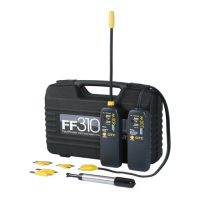Page 4
6.10 The short circuit is located in the area where the audio/visual signal stops or
changes signifi cantly.
6.11 When the test is completed, switch off the FF310T unit pressing the On/Off button
and disconnect from circuit.
Note: The closer the FF310R’s sensor is to the wire carrying the signal, the faster the
beeping and the fl ashing will be. Some times it will prove advantageous to reduce
the sensitivity level to pint point more accurately the faulty area.
7 - Wire tracing
Wire tracing hook up and procedures are essentially the same as for locating short
circuits. The FF310T sees the load (light bulb, accessory, etc.) as a weak short circuit or
connection to ground. For wire tracing simply follow the wire with positive (beeping and
fl ashing) audio/visual indicator’s feedback on the FF310R from source to load.
For step by step directions please refer to point 6– Locating Short Circuits, for some
hints and specifi c differences refer to the notes below:
The type and size of load connected to the circuit (impedance or resistance to ground)
determines the amount of current allowed to fl ow in the circuit. Small loads (low Watt-
age lamps, electronic systems, etc.) will reduce the range of the FF310R accordingly.
In cases where the full range of the FF310R is required to follow the wire, it may prove
advantageous to use one of the two methods described below:
•
Tracing wires downstream (from supply to load): replacing the load for a full short
circuit allows the FF310R to work at its maximum capabilities. Before proceeding,
remove all electrical power from the circuit, connect the FF310T in series with the
wire to trace, short circuit the load to ground (refer to Hook Up Reference Chart
Fig.2 and 3), then reconnect power and follow instructions in section 6 – Locating
Short Circuits.
•
Tracing wires upstream (from load to supply): If more convenient, wires can also be
traced the other way around, by replacing the load with the FF310T (Fig. 5 of Hook Up
reference chart). To do this, fi rst remove power from the circuit, disconnect the load
and connect the FF310T in its place. Apply power to the circuit and follow instructions
in section 6 – Locating Short Circuits.
8 – Locating Current Leaks
Hook up and procedures for locating current leaks are essentially the same as for
locating short circuits. The FF310T sees the leak as a weak short circuit or
connection to ground. For locating a current leak simply follow the wire with positive
(beeping and fl ashing) audio/visual indicator’s feedback on the FF310R, from source to leak
location (short circuit).
For step by step directions please refer to point 6 – Locating Short Circuits, for some
hints and specifi c differences refer to the notes below:
Current leak notes:
•
The type and size of the leak in the circuit (impedance or resistance to ground)
determines the amount of current fl owing in the circuit. Small leaks (i.e. low current)
will reduce the range of the FF310R accordingly. In all cases the FF310R’s sensor
should be positioned as close as possible to the wires, in order to maximize the signal
captured by the FF310R, and set to a higher sensitivity level . For hook up refer to the
Hook Up Reference Chart Fig. 2 and 3 in Page 6.

